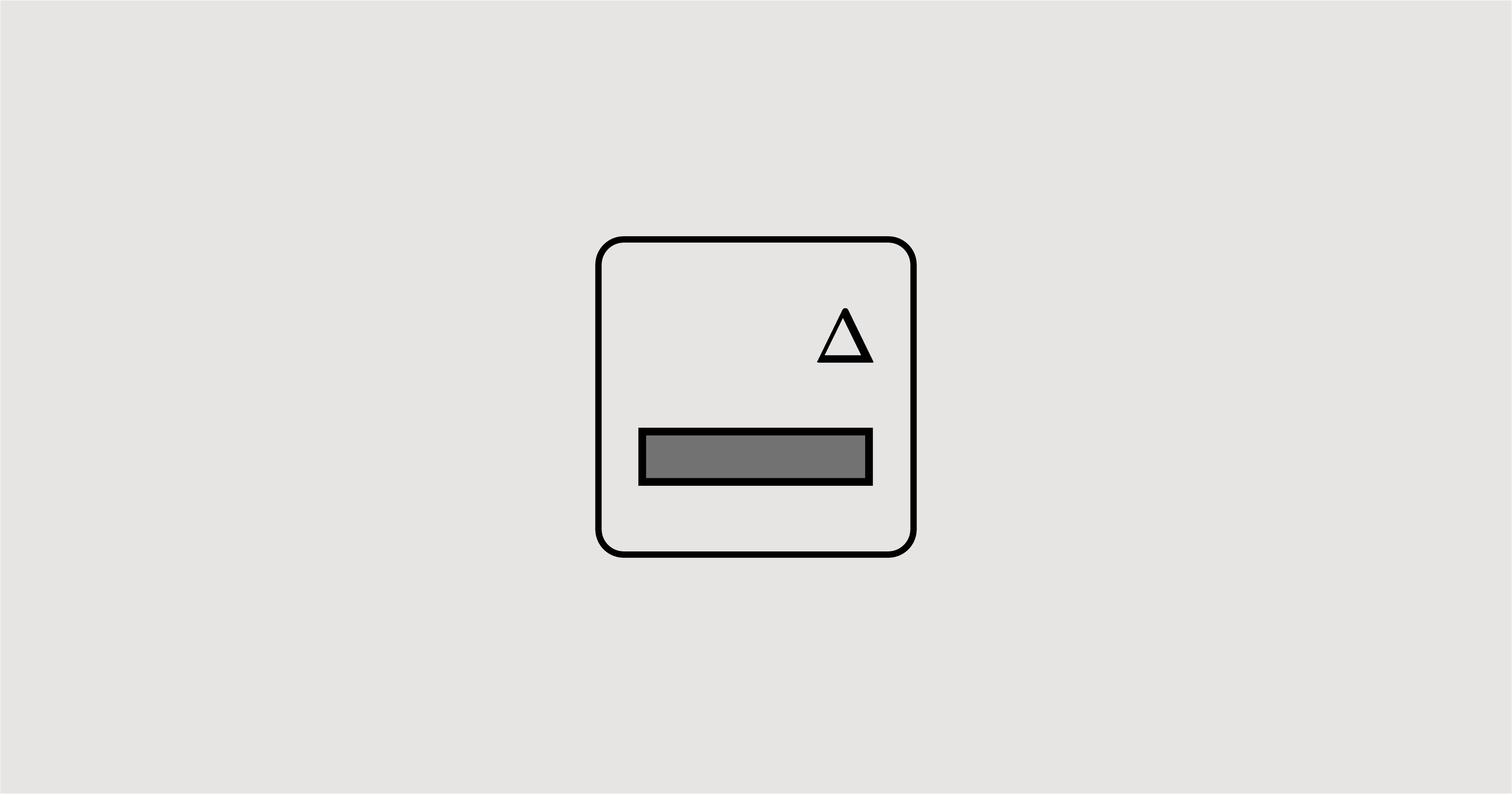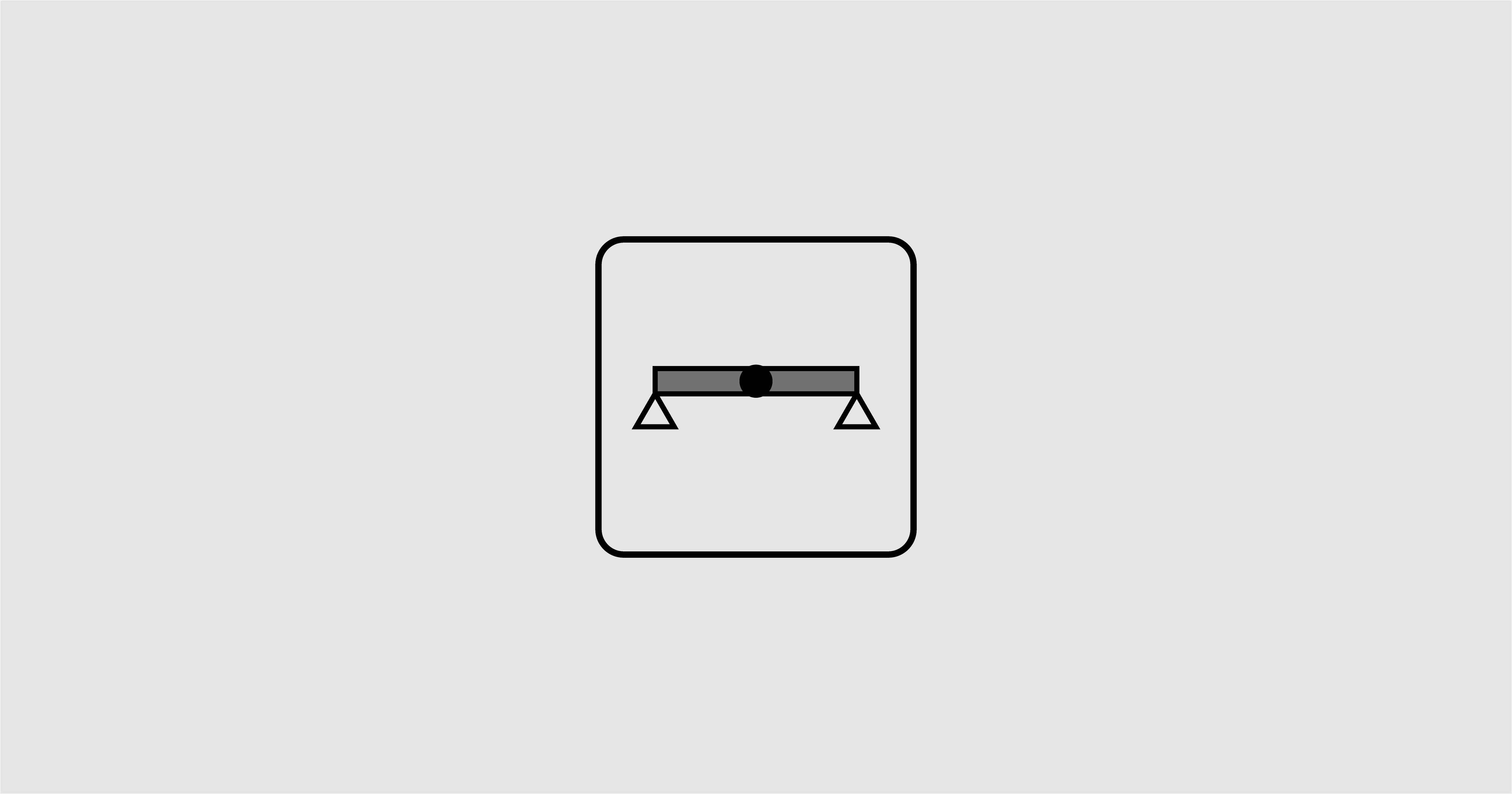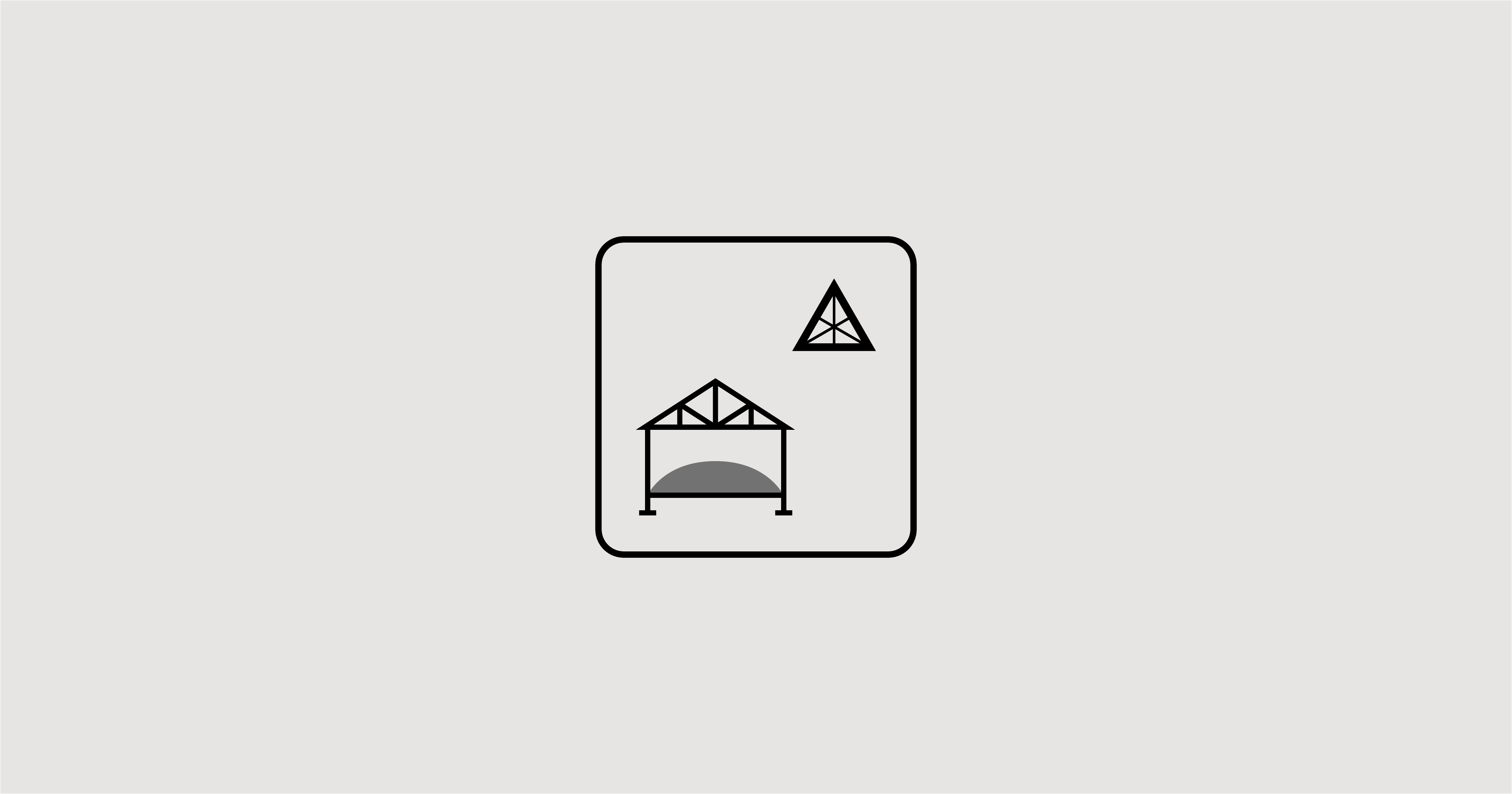This post shows a sample linear structural analysis of a 2D determinate simple beam with static loads using the classical approach.
This example shows units in SI and English. The English system is in parentheses.
In terms of computations, however, it will primarily be in the SI system. The author converted the answer from the SI solution to English to reflect the latter system. It only applies to definite values, not equations.
We will update this post to reflect solutions in the English system soon.
Structural Model
Let's consider a simple double overhanging beam example. It is assumed to have a uniform section of the same material.
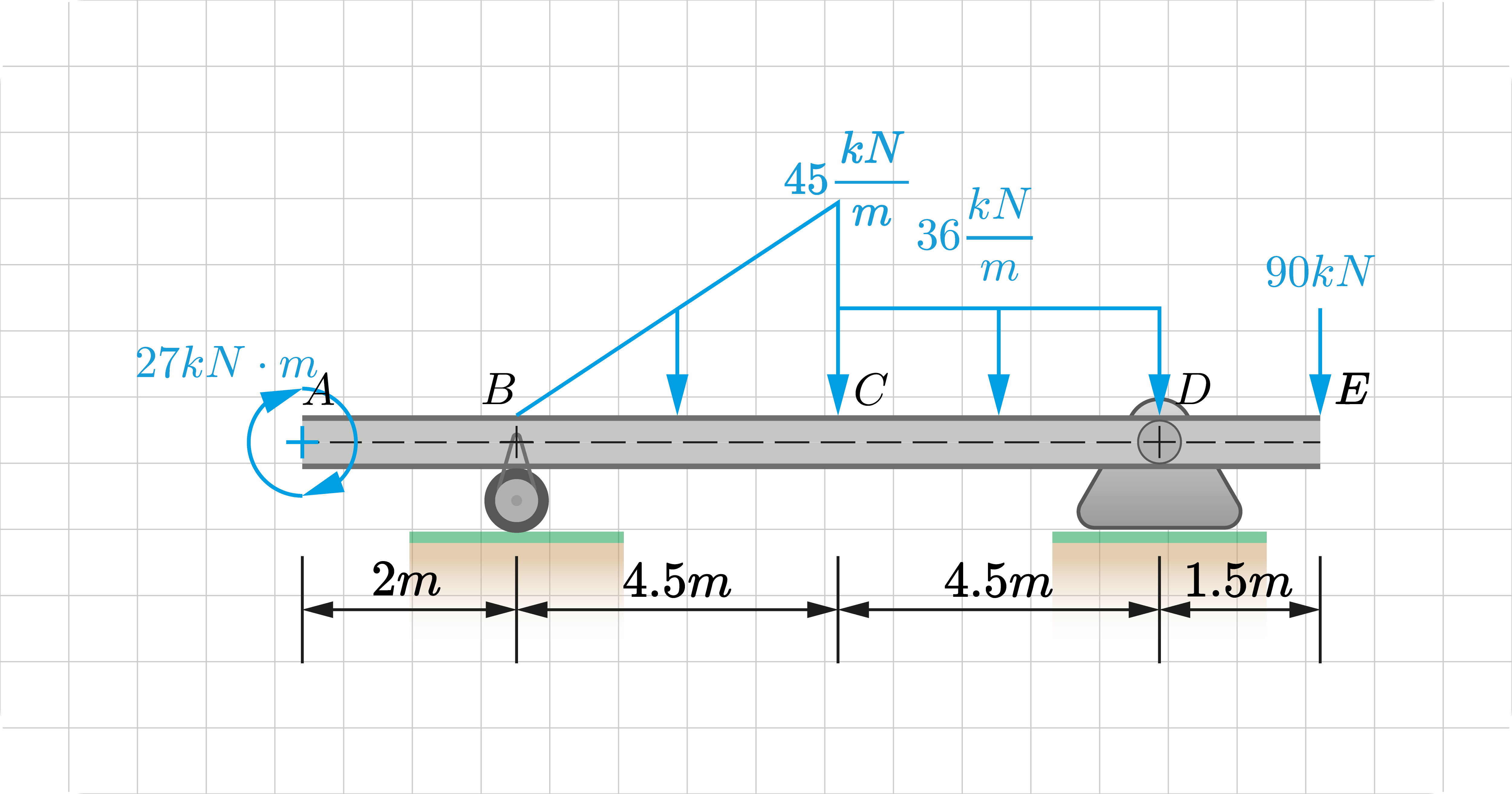
Structural Loads
The beam has the following static loads:
- A \(27kN•m (19.91kip•ft)\) clockwise moment.
- A varying linear load from \(0\) to \(45kN/m (3.08kip/ft)\).
- A uniform load of \(36kN/m (2.47kip/ft)\).
- A \(90kN (20.23kip)\) concentrated load.
We can see the position and direction of these loads in the following figure. We can talk more about this in preparation.
Structural Analysis
Type of Analysis: Classical Approach, Linear Analysis, Static Loads, Plane Beam, Determinate Beam
Preparation
Before analyzing a structure, we'll need to make some preparations first. That includes setting up our references and finding their determinacy.
Set-Up References

An excellent structural analysis must have a uniform mathematical understanding of the structure. It ensures that other people can easily understand your results.
We first place a Cartesian grid with its origin defined by our preference. In this case, let's assign the origin \(A(0, 0)\) at the leftmost point of the beam. Consequently, the x-axis will run along the length of the beam with the y-axis perpendicular to it at the origin.
We also need to identify the location of all points of interest: the location of supports, change in loads, and differences in the beam's cross-sectional properties. Starting from \(A\) and going toward the other end, we identify the following points of interest:
- \(A(0.0m, 0.0m), A(0.0ft, 0.0ft)\). The \(27kN•m (19.91kip•ft)\) clockwise moment.
- \(B(2.0m, 0.0m), B(6.56ft, 0.0ft)\). The roller support and the start of varying linear load \(0\).
- \(C(6.5m, 0.0m), C(21.33ft, 0.0ft)\). The end of the varying linear load of \(45kN/m (3.08kip/ft)\) ↓ and the start of the uniform distributed load of \(36kN/m (2.47kip/ft)\) ↓,
- \(D(11.0m, 0.0m), D(36.09ft, 0.0ft)\). The end of the uniform distributed load \(36kN/m (2.47kip/ft)\) ↓ and the hinge support, and
- \(E(12.5m, 0.0m), E(41.01ft, 0.0ft)\). The \(90kN (20.23kip)\) downward concentrated load.
You can label each joint according to your preference. The most important thing is that its coordinates must be defined appropriately.
Determinacy
We need to find the structure's determinacy \(D\) to know our approach.
For a 2D beam, it is:
\(D=r-(3+e_c)\)
This beam example have three reaction components: \(A_h\), \(A_v\), and \(R_E\), and no internal connections \(e_c = 0\); hence \(D=0\)
\(D=3-(3+0)=0\)
A determinacy of zero indicates that the structure can be analyzed using only the equilibrium equations.
Main Analysis
Stability
The first requirement is to know if our structure is externally and internally stable.
Let's examine its external stability first:
- The reaction components \(A_h, A_v, R_E\) are not collinear, parallel, or concurrent with each other.
- The determinacy is equal to zero.
From these observations, we can conclude the beam is externally stable. In terms of its internal stability, the beam arrangement doesn't pose any risks of excessive deformation or immediate collapse; hence, it's internally stable.
Since the structure is externally and internally stable, we can proceed with the analysis. If it is unstable, we may have to adjust its model before proceeding.
Reactions
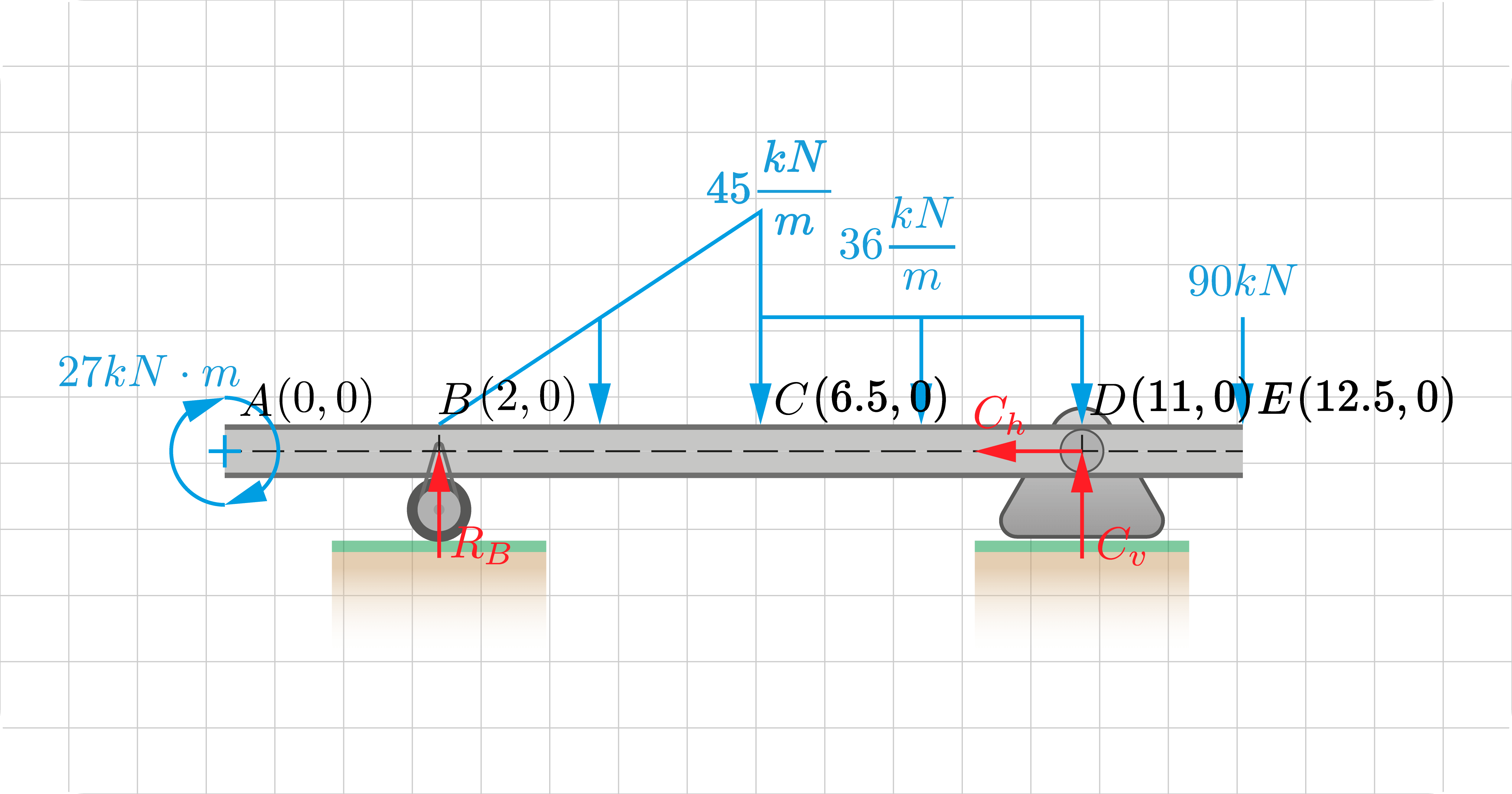
The second requirement for a complete analysis is to compute the support loads of the structure. Solving for the components enables us to understand the transfer of loads.
For a determinate structure, solving for its reactions is straightforward. To solve it, always remember that the whole model must obey the laws of equilibrium.
As a demonstration, we first break the support loads into their components (not their resultant) along the axes. In our example, we have three components:
- We assume \(D_h\) to be acting towards the left, and
- \(R_B\) and \(D_v\) are acting upwards.
Then, applying the equilibrium equations:
\(\sum{F_h}=0]\space{\rightarrow_+}\)
\(D_h=0\)
\(\sum{M_B}=0]\space{\circlearrowright_+}\)
\(27+\frac{1}{2}(4.5)(45)(4.5\times\frac{2}{3})+36(4.5)(4.5+\frac{4.5}{2})+90(4.5+4.5+1.5)-D_v(4.5+4.5)=0\)
\(D_v=263.25kN (59.18kip)\)
\(\sum{F_v}=0]\space{\uparrow_+}\)
\(R_B+D_v-\frac{1}{2}(4.5)(45)-36(4.5)-90=0\)
\(R_B=90kN (20.23kip)\)
From our calculations, the reaction components of the structure are:
\(D_h=0\)
\(D_v=263.25kN (59.18kip)\)
\(R_B=90kN (20.23kip)\)
If our answer is negative, the assumed direction is wrong, and the correct one is the opposite.
Force Analysis
The third requirement for a complete analysis is understanding the internal force and stress developed on the structure due to the applied loads.
We have four types of stresses to analyze: axial, shear, moment, and torsion. Typically, we do these by modeling the behavior using functions and diagrams.
In our example, we limit to shear and moment only.
Modeling Shear and Moment Behavior
We can use shear and moment equations and graphs to describe the beam's internal behavior.
Creating these equations and diagrams deserves a separate section. Learn more about how to construct these using these individual posts:
The following shows our beam's shear and moment equations and diagrams. You can view the complete solution in these links:
Shear
SI Equations
\(V_{AB}=0,\{0\leq{x}\leq2\}\)
\(V_{BC}=-5x^2+20x+70,\{2\leq{x}\leq6.5\}\)
\(V_{CD}=-36x+222.75,\{6.5\leq{x}\leq11\}\)
\(V_{DE}=90,\{11\leq{x}\leq12.5\}\)
Diagram
Moment
SI Equations
\(M_{AB}=27,\{0\leq{x}\leq2\}\)
\(M_{BC}=-\frac{5}{3}x^3+10x^2+70x-139\frac{2}{3},\{2\leq{x}\leq6.5\}\)
\(M_{CD}=-18x^2+222.75x-407.25,\{6.5\leq{x}\leq11\}\)
\(M_{DE}=90x-1125,\{11\leq{x}\leq12.5\}\)
Diagram
Deflections
The final requirement is to analyze the structure's deflection. In this part, we analyze the translations and rotations of the object from their original position.
We have two types to analyze: rotation and translation. As in the previous part, we can describe their behavior using functions and diagrams.
The topic of deflection deserves a separate section. There are many ways how to explain a structure's movement, such as the following:
The following shows our beam's deflection equations and diagrams.
Rotation/Slope
SI Equations
\(\theta_{AB}=\frac{1}{EI}(27x-877.92),\{0\leq{x}\leq2\}\)
\(\theta_{BC}=\frac{1}{EI}(-\frac{5}{12}x^4+\frac{10}{3}x^3+\frac{70}{2}x^2-139\frac{2}{3}x-704.59),\{2\leq{x}\leq6.5\}\)
\(\theta_{CD}=\frac{1}{EI}(-6x^3+111.375x^2-407.25x-372.75),\{6.5\leq{x}\leq11\}\)
\(\theta_{DE}=\frac{1}{EI}(45x^2-1125x+7567.88),\{11\leq{x}\leq12.5\}\)
Diagram
Vertical Translation
SI Equations
\(\Delta_{AB}=\frac{1}{EI}(13.5x^2-877.92x+1701.84),\{0\leq{x}\leq2\}\)
\(\Delta_{BC}=\frac{1}{EI}(-\frac{1}{12}x^5+\frac{5}{6}x^4+\frac{35}{3}x^3-\frac{419}{6}x^2-704.59x+1584.51),\{2\leq{x}\leq6.5\}\)
\(\Delta_{CD}=\frac{1}{EI}(-1.5x^4+37.125x^3-203.625x^2-372.75x+1287),\{6.5\leq{x}\leq11\}\)
\(\Delta_{DE}=\frac{1}{EI}(15x^3-562.5x^2+7567.88x-35149.13),\{11\leq{x}\leq12.5\}\)
Diagram
You can view the complete solution in these separate links:





